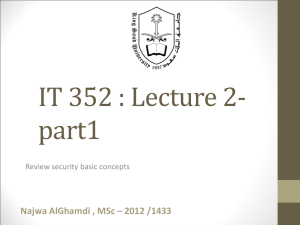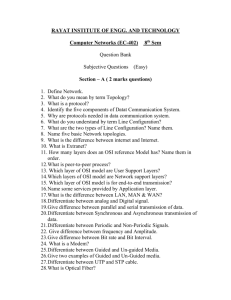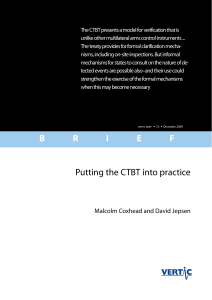On-site inspections for the CTBT: long
advertisement
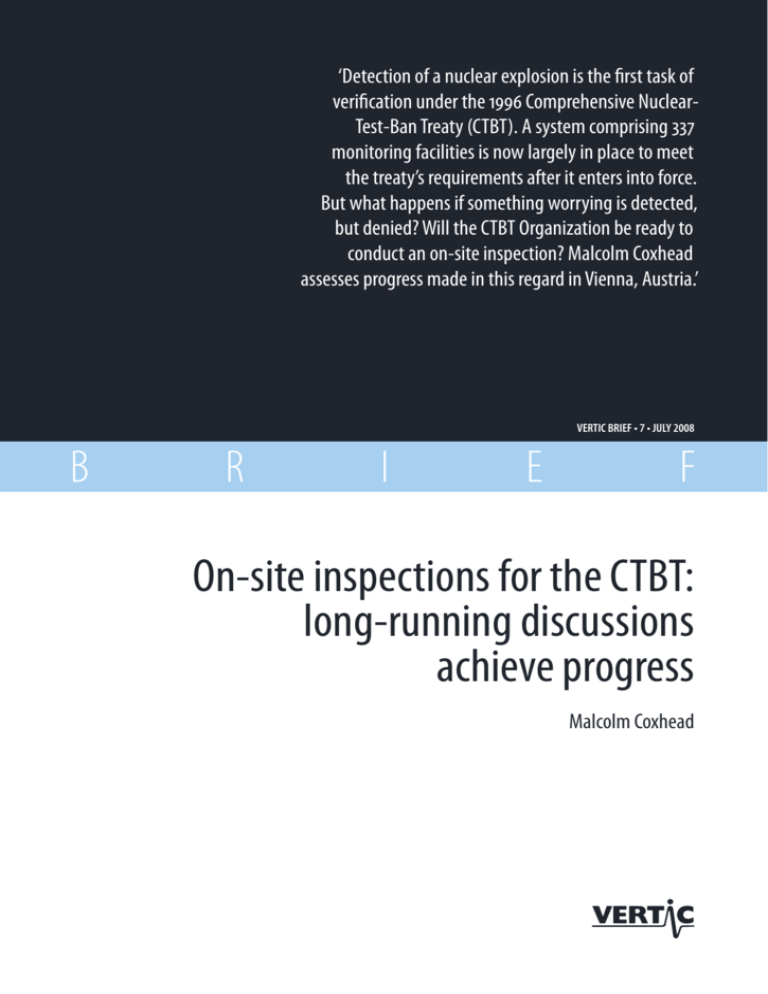
‘Detection of a nuclear explosion is the first task of verification under the 1996 Comprehensive NuclearTest-Ban Treaty (CTBT). A system comprising 337 monitoring facilities is now largely in place to meet the treaty’s requirements after it enters into force. But what happens if something worrying is detected, but denied? Will the CTBT Organization be ready to conduct an on-site inspection? Malcolm Coxhead assesses progress made in this regard in Vienna, Austria.’ VERTIC BRIEF • 7 • JULY 2008 B R I E F On-site inspections for the CTBT: long-running discussions achieve progress Malcolm Coxhead Even though entry into force of the 1996 Comprehensive Nuclear-TestBan Treaty (CTBT) is not quite within sight, its verification regime has been under development for more than 10 years—through the work of the Preparatory Commission (PrepCom) for the Comprehensive Nuclear-Test-Ban Treaty Organiza­ tion (CTBTO). The International Monitoring System is now largely in place, and the International Data Centre is functioning to a high standard. In addition, work to develop another important facet of CTBT verification, on-site inspection (OSI), is continuing. However, the potentially intrusive nature of OSI has made this effort politically complex and often fraught. Useful progress has been slow in coming. Much has yet to be done to achieve a reasonable level of OSI readiness, although the last few years have seen tangible advances, particularly in discussions to elaborate a Manual of operational procedures. The story of the CTBT’s OSI mechanism is not unlike that of other on-site inspection regimes in that it combines years of long and patient discussions to build common understanding with short and intense periods of high-level negotiation. In this case, a relatively short high-level negotiation happened first—the negotiation of the treaty— providing a framework for OSI. Long discussions since have been to forge common understanding on how the framework should be applied. Of course, such discussions take longer if there is no deadline, such as looming entry into force of the CTBT. Described here is the process to elaborate the inspection procedures to be included in an Operational Manual for OSI. This is one of the more time-intensive tasks of the PrepCom’s technical working group (Working Group B). But it is not the whole story of OSI: the development of specialised equipment, inspector training arrangements, and a technical and logistical methodology is occurring in parallel. A brief history of efforts to elaborate the Manual Operational procedures for the different elements of the CTBT’s verification system will be specified in Operational Manuals. The Prep­ Com is charged with developing draft Manuals, including one on OSI, for approval by the first Confer­ ence of States Parties of the CTBT. Within Working Group B, a friend of the Chair, typically titled Task Leader, leads work on each of the various assignments involved in creating a draft Manual.1 In the first years of the PrepCom, the efforts of Working Group B centred on developing an OSI concept that might be translated into an OSI Operational Manual. Progress was made on some issues, yet it became clear that further movement would depend on a textbased negotiation to clarify and address disparate views. An Initial Draft Rolling Text (IDRT) was compiled during 2000, with national papers serving as the basis. A first reading of the 577-page IDRT took place during some 80 days of meetings between 2001 and 2005, with views collected, issues discussed and some text settled. Far more brackets were added than were ever removed, but the solutions to some key issues have their 1 Dr Vitaliy Shchukin (Russian Federation) initially led the process to elaborate a draft OSI Operational Manual. Ambassador Arend Meerburg (Netherlands) assumed the task from May 2001 to mid2004, followed by Mr Malcolm Coxhead (Australia). 2 On-site inspections for the CTBT Malcolm Coxhead genesis in the 766-page Annotated Draft Rolling Text (ADRT) that emerged from this first reading. In parallel with the first reading, the Task Leader was preparing his own vision text. If entry into force of the CTBT had been a prospect around 2005, such a vision text might have become the foundation for further negotiation. It was not, though, and some delegations objected to elements of the vision text. Clearly, it was impossible to re-read the heavily bracketed rolling text, so delegations had to identify a third way. To address the problem, they agreed to an informal methodology for the second round of elaboration. The Task Leader, working with national experts who were serving as ‘friends’, created, and consulted with delegations on, a series of draft model texts (DMTs) that he hoped in time would become the new rolling text. Since early 2005, Working Group B has concentrated primarily on the development of these DMTs and their consolidation into a single manuscript. The flexibility afforded by utilising these informal documents has allowed the Group to find working solutions to many issues. At present, the heavily bracketed rolling text remains the formal basis for the discussions of Working Group B, although dele­ gations are expected to consider a consolidation of the DMTs as a new basis for the elaboration process in early 2009. Throughout 2008, the CTBTO PrepCom’s Provisional Technical Secretariat (PTS) and OSI experts have been focusing mainly on preparations for a major inspection exercise in August–September in Austria and Kazakhstan (see Box 1). Work on the draft OSI Operational Manual has, therefore, been suspended for a year. When it resumes in 2009, it should concentrate on resolving outstanding issues in the model text, and on integrating any lessons learned in the Integrated Field Exercise. While the timing of entry into force of the CTBT remains unclear, it is difficult to plan for an end game to the negotiations. In the meantime, it has been proposed that a near-final draft of the OSI Operational Manual could be prepared ahead of a full-scale mock inspection, perhaps in 2012. Box 1 Integrated Field Exercise 2008 A 2003 review of the programme to develop on-site inspections (led by retired Australian Ambassador Richard Starr) has been widely credited with reinvigorating the PrepCom’s work on OSI. Its recommendations included a proposal to conduct a near-full-scale inspection exercise. CTBT signatories recognised the value of such exercises for testing many aspects of OSI, and tasked the CTBTO’s Provisional Technical Secretariat (PTS) with making preparations. The exercise is to be conducted from 25 August–30 September 2008, for one week in Vienna, Austria, and then at the former Semipalatinsk nuclear test site in Kazakhstan. It will be based on a fictional scenario that has been tailored to an inspection area of up to 1,000 square kilometres. An inspection team of PTS and national experts on OSI will plan and conduct inspection activities in response to evidence of a possible nuclear explosion, and prepare a report of their findings. They will do so in negotiation with a team representing the interests of a fictional inspected State Party. Key issues in the Manual A key balancing act facing international on-site verification arrangements is to maximise effectiveness while minimising intrusiveness. For CTBT OSIs, effectiveness can be defined as timely entry for a competent and properly equipped inspection team to an area in which a suspicious event has occurred to gather, assess and report information needed to clarify whether a nuclear explosion has occurred. Intrusiveness, meanwhile, pertains to the risk of disclosure of national security information not related to the purpose of an inspection, or to the potential for interference with normal activities in the inspected State Party. One view is that since CTBT OSI would focus on the inspection of land, and not facilities, the likelihood of disclosure of sensitive information is considerably less than in inspections under, for example, the 1993 Chemical Weapons Conven­ tion. As such, extensive provisions in an Operational Manual to address confidentiality concerns will unnecessarily hamstring an inspection team. Another view is that CTBT OSI inspection techniques (especially geophysical imaging, radioactive sampling and overflight) do The exercise will employ and test much of the work that the PrepCom has done to prepare for an actual OSI, including inspector training, equipment and logistics, as well as inspection procedures in the form of a Test Manual. The OSI Test Manual was developed in 2006–07. During two intensive workshops, experts reviewed a compilation of draft material for the OSI Operational Manual to harmonize the various elements—and to forge working solutions to as many unresolved issues as possible. Working Group B agreed to the use of the 174-page product in the Integrated Field Exercise. Despite the recommendation of the 2003 review, the Integrated Field Exercise will not be a near-full-scale exercise due to limitations on the equipment, personnel and other resources available to the PTS. Similarly, the OSI Test Manual sidesteps a number of issues that delegations believe must be clarified, such as off-site analysis of environmental samples. It will nevertheless be a valuable test of work done to date, and its results should help to define the work that needs to happen to attain an acceptable level of OSI readiness. have the potential to reveal national security information, and that the Operational Manual must contain checks and balances that reflect those treaty provisions that highlight the right of a state to introduce measures it deems necessary to protect such information. The Operational Manual provisions that deal with managed access and protection of information classified as confidential are at the heart of the debate. Approaches to both of these features of CTBT OSI are broadly agreeable to delegations, having their origins in the late stages of the first reading of the IDRT. That they have been further developed over time has provided other aspects of the discussions with a firmer base. Not all issues have been resolved, however. The relationship between data protection arrangements and national laws remains an area of complication. Another is differing assessments of the consequences of managed access. In this regard some take the view that an inspected State Party should be spared, as far as possible, the need to exercise managed access as this may be represented as noncooperation. Others, though, believe that limits on inspector access will Malcolm Coxhead On-site inspections for the CTBT 3 Malcolm Coxhead is the Section Head for CTBT implementation at the Australian Safeguards and Non-Proliferation Office (ASNO), responsible for implementation of CTBT obligations and oversight of the International Monitoring System in Australia. He has led the process to elaborate a draft OSI Operational Manual in CTBT PrepCom’s Working Group B since mid-2004. Current Funders Chatham House; Ford Foundation; Joseph Rowntree Charitable Trust (JRCT); Netherlands Ministry of Foreign Affairs; Norway Ministry of Foreign Affairs; Norwegian Radiation Protection Authority (NRPA); Ploughshares Fund; Strategic Programme Fund of the UK Foreign and Common­ wealth Office (FCO); UK Ministry of Defence (MOD) agreements); Dr Patricia Lewis (arms control and disarmament agreements); Peter Marshall CMG OBE (seismic verification); Dr Robert Mathews (chemical and biological disarmament); Dr Colin McInnes (Northern Ireland decommissioning); Dr Graham Pearson (chemical and biological disarmament); Dr Arian Pregenzer (co-operative monitoring); Dr Rosalind Reeve (environmental law) Disclaimer The views expressed are not necessarily those of VERTIC or the Australian Safeguards and NonProliferation Office (ASNO) Board of Directors Dr. Owen Greene (Co-Chair); Gen. Sir Hugh Beach, GBE, OBE, KCB, MC (Co-Chair); Dr. Molly Anderson; Dr. Wyn Bowen; Dr. Duncan Brack; Dr. Nicholas A. Sims; Dr. Susan Willett VERTIC Development House, 56–64 Leonard Street London EC2A 4LT, United Kingdom Personnel Angela Woodward, Executive Director BA (Hons), LLB, LLM; Hassan Elbahtimy, Intern Bsc (Hons), Graduate Diploma; Rocio Escauriaza, Research Assistant, LLB, LLM; Larry MacFaul, Senior Researcher, BA (Hons), MSc; Andreas Persbo, Senior Researcher, LLB, LLM; Scott Spence, CBW Legal Officer, LLB, LLM; Unini Tobun, Administrator, BA(Combined Hons), MA International Verification Consultants Network Richard Butler AO (arms control and disarmament verification); Dr Roger Clark (seismic verification); Jayantha Dhanapala (arms control and disarmament); Dr Jozef Goldblat (arms control and disarmament agreements); Dr Edward Ifft (arms control and disarmament Tel +44 (0)20 7065 0880 Fax +44 (0)20 7065 0890 E-mail info@vertic.org Website www.vertic.org Editor Angela Woodward Sub-editor, design and layout Richard Jones ISSN 1740-8083 © VERTIC 2008 Building trust through verification be politically manageable as long as the state fulfils its obligation to find alternative ways to demonstrate compliance. Useful progress has also been made in developing search logic for the conduct of an OSI. This aims to focus inspection activities on a smaller area as soon as practicable (and reduce intrusiveness) while allowing the inspection team to conduct broad-area searches when required. In light of progress on these and other overarching issues, it has proven easier to advance the development of procedures for the application of inspection techniques (such as passive seismic monitoring, radionuclide monitoring and sampling). Nevertheless, differences remain over, inter alia, how much detailed guidance is needed for geophysical techniques such as ground- penetrating radar, magnetic and gravitational field mapping and active seismic measurements. Differences remain too over the key issue of how to assess the relevance of data gathered by an inspection team to the purpose of the inspection. Many argue that logically, this is the preserve of the inspectors; but the CTBT leaves the question open. Whether information or data are relevant to the purpose of the inspection is an important criterion that the treaty applies when specifying how it should be handled. Absent friends Not all states that are likely to have strong views on OSI are currently engaged in the discussions. The absence of the United States since 4 On-site inspections for the CTBT Malcolm Coxhead 2002 has been noted at times, suggesting that it may not be possible to conclude certain issues until it returns. Some other countries whose ratification is required for entry into force of the CTBT, such as India and Pakistan, almost certainly have strong views. However, development of an OSI capability involves many complexities, and deferring important discussions until all players are at the table is not sensible. In the meantime, those states that are actively engaged in developing OSI and the Operational Manual have used the time available to advance common understanding and to develop many working solutions to difficult issues. When entry into force occurs, and the Operational Manual needs to be finalised, some of these solutions may not stand up to demands of newly arrived delegations, but many will.




